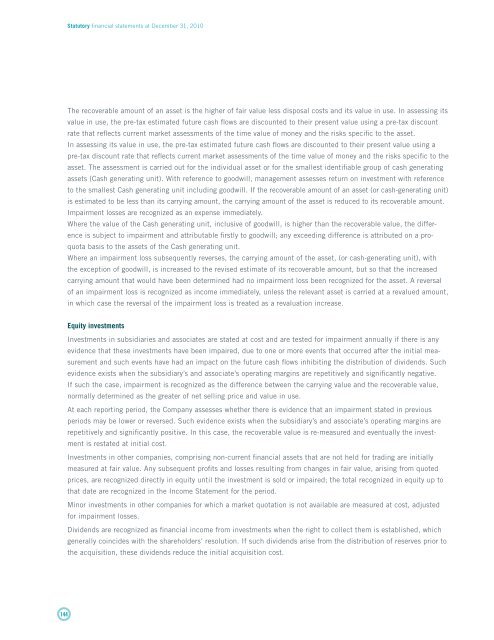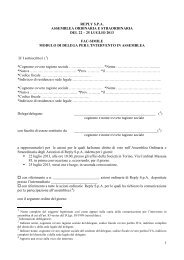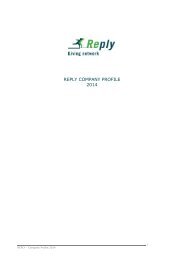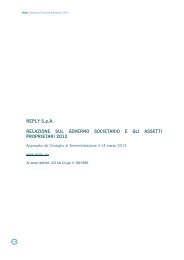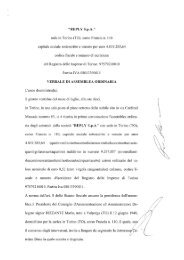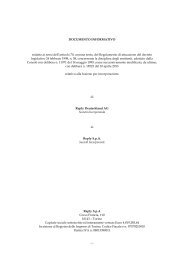Reply SpA
Reply SpA
Reply SpA
Create successful ePaper yourself
Turn your PDF publications into a flip-book with our unique Google optimized e-Paper software.
Statutory financial statements at December 31, 2010<br />
The recoverable amount of an asset is the higher of fair value less disposal costs and its value in use. In assessing its<br />
value in use, the pre-tax estimated future cash flows are discounted to their present value using a pre-tax discount<br />
rate that reflects current market assessments of the time value of money and the risks specific to the asset.<br />
In assessing its value in use, the pre-tax estimated future cash flows are discounted to their present value using a<br />
pre-tax discount rate that reflects current market assessments of the time value of money and the risks specific to the<br />
asset. The assessment is carried out for the individual asset or for the smallest identifiable group of cash generating<br />
assets (Cash generating unit). With reference to goodwill, management assesses return on investment with reference<br />
to the smallest Cash generating unit including goodwill. If the recoverable amount of an asset (or cash-generating unit)<br />
is estimated to be less than its carrying amount, the carrying amount of the asset is reduced to its recoverable amount.<br />
Impairment losses are recognized as an expense immediately.<br />
Where the value of the Cash generating unit, inclusive of goodwill, is higher than the recoverable value, the difference<br />
is subject to impairment and attributable firstly to goodwill; any exceeding difference is attributed on a proquota<br />
basis to the assets of the Cash generating unit.<br />
Where an impairment loss subsequently reverses, the carrying amount of the asset, (or cash-generating unit), with<br />
the exception of goodwill, is increased to the revised estimate of its recoverable amount, but so that the increased<br />
carrying amount that would have been determined had no impairment loss been recognized for the asset. A reversal<br />
of an impairment loss is recognized as income immediately, unless the relevant asset is carried at a revalued amount,<br />
in which case the reversal of the impairment loss is treated as a revaluation increase.<br />
Equity investments<br />
Investments in subsidiaries and associates are stated at cost and are tested for impairment annually if there is any<br />
evidence that these investments have been impaired, due to one or more events that occurred after the initial measurement<br />
and such events have had an impact on the future cash flows inhibiting the distribution of dividends. Such<br />
evidence exists when the subsidiary’s and associate’s operating margins are repetitively and significantly negative.<br />
If such the case, impairment is recognized as the difference between the carrying value and the recoverable value,<br />
normally determined as the greater of net selling price and value in use.<br />
At each reporting period, the Company assesses whether there is evidence that an impairment stated in previous<br />
periods may be lower or reversed. Such evidence exists when the subsidiary’s and associate’s operating margins are<br />
repetitively and significantly positive. In this case, the recoverable value is re-measured and eventually the investment<br />
is restated at initial cost.<br />
Investments in other companies, comprising non-current financial assets that are not held for trading are initially<br />
measured at fair value. Any subsequent profits and losses resulting from changes in fair value, arising from quoted<br />
prices, are recognized directly in equity until the investment is sold or impaired; the total recognized in equity up to<br />
that date are recognized in the Income Statement for the period.<br />
Minor investments in other companies for which a market quotation is not available are measured at cost, adjusted<br />
for impairment losses.<br />
Dividends are recognized as financial income from investments when the right to collect them is established, which<br />
generally coincides with the shareholders’ resolution. If such dividends arise from the distribution of reserves prior to<br />
the acquisition, these dividends reduce the initial acquisition cost.<br />
144


